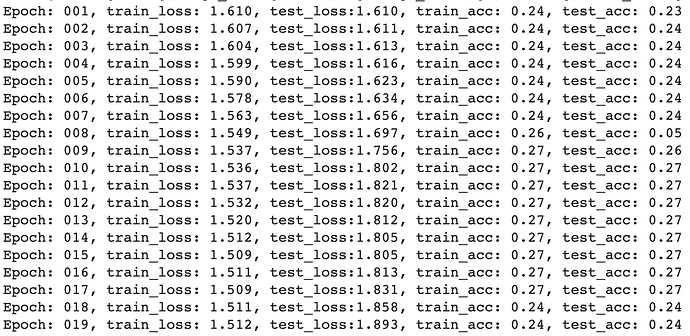Hi everyone,
I am using a GCN model to perform node classification.
The implementation of the GCN model was found in the following repo: “https://colab.research.google.com/github/zaidalyafeai/Notebooks/blob/master/Deep_GCN_Spam.ipynb#scrollTo=Hhabp4QvoP6V”
The issue is that the accuracy I obtain is about 0.22 and the model does not seem the learn from the graph data. A random classifier would indeed give an accuracy close to 0.2 since there are 5 classes in my data.
The implementation of the GCN model is:
class Net(nn.Module):
def init(self):
super(Net, self).init()
self.conv1 = SplineConv(1, 16, dim=1, kernel_size=5)
self.conv2 = SplineConv(16, 32, dim=1, kernel_size=5)
self.conv3 = SplineConv(32, 64, dim=1, kernel_size=7)
self.conv4 = SplineConv(64, 128, dim=1, kernel_size=7)
self.conv5 = SplineConv(128, 128, dim=1, kernel_size=11)
self.conv6 = SplineConv(128, 5, dim=1, kernel_size=11)
self.dropout = 0.25
def forward(self, batch):
x, edge_index, edge_attr = batch.x, batch.edge_index, batch.edge_attr
# batch = batch.batch
x = F.elu(self.conv1(x, edge_index, edge_attr))
x = self.conv2(x, edge_index, edge_attr)
x = F.elu(self.conv3(x, edge_index, edge_attr))
x = self.conv4(x, edge_index, edge_attr)
x = F.elu(self.conv5(x, edge_index, edge_attr))
x = self.conv6(x, edge_index, edge_attr)
# x = pyt_geom.global_mean_pool(x, batch)
x = F.dropout(x, training=self.training)
output = F.softmax(x, dim=1)
return output
The rest of the implementation is the same as the code in the repo link.
The graph data has the following format:
“Batch(batch=[43267], edge_attr=[475194, 1], edge_index=[2, 475194], x=[43267, 1], y=[43267])” where the edge attributes and node features are set to 1. They were set to 1 because the only data I have is the edge list of the network.
Thank you for your help!
